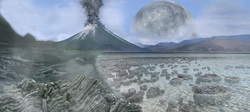 |
| Artist's impression
of an Archean landscape. |
Archean
The Archean Eon ( /ɑːrˈkiːən/ ar-KEE-ən, also spelled
Archaean or Archæan) is one of the four geologic eons of
Earth's history, occurring 3,875 to 2,750 million years
ago (4 to 2.5 Gya). During the Archean, the Earth's
crust had cooled enough to allow the formation of
continents and the beginning of life on Earth.
Etymology and changes in
classification
The word 'Archean' comes from the ancient Greek word
Αρχή (Arkhē), meaning 'beginning, origin.' It was first
used in 1872, when it meant "of the earliest geological
age." Before the Hadean Eon was recognized, the Archean
spanned Earth's early history from its formation about
4,540 million years ago (Mya) until 2,500 Mya.
Instead of being based on stratigraphy, the beginning
and end of the Archean Eon are defined chronometrically.
The eon's lower boundary or starting point of 4 Gya (4
billion years ago) is officially recognized by the
International Commission on Stratigraphy. |
|
Geology
When the Archean began, the Earth's heat flow was nearly
three times as high as it is today, and it was still
twice the current level at the transition from the
Archean to the Proterozoic (2,500 Ma). The extra heat
was the result of a mix of remnant heat from planetary
accretion, from the formation of the metallic core, and
from the decay of radioactive elements.
Although a few mineral grains are known to be Hadean,
the oldest rock formations exposed on the surface of the
Earth are Archean. Archean rocks are found in Greenland,
Siberia, the Canadian Shield, Montana and Wyoming
(exposed parts of the Wyoming Craton), the Baltic
Shield, the Rhodope Massif, Scotland, India, Brazil,
western Australia, and southern Africa. Granitic rocks
predominate throughout the crystalline remnants of the
surviving Archean crust. Examples include great melt
sheets and voluminous plutonic masses of granite,
diorite, layered intrusions, anorthosites and monzonites
known as sanukitoids. Archean rocks are often heavily
metamorphized deep-water sediments, such as graywackes,
mudstones, volcanic sediments, and banded iron
formations. Volcanic activity was considerably higher
than today, with numerous lava eruptions, including
unusual types such as komatiite. Carbonate rocks are
rare, indicating that the oceans were more acidic due to
dissolved carbon dioxide than during the Proterozoic.
Greenstone belts are typical Archean formations,
consisting of alternating units of metamorphosed mafic
igneous and sedimentary rocks, including Archean felsic
volcanic rocks. The metamorphosed igneous rocks were
derived from volcanic island arcs, while the
metamorphosed sediments represent deep-sea sediments
eroded from the neighboring island arcs and deposited in
a forearc basin. Greenstone belts, being both types of
metamorphosed rock, represent sutures between the
protocontinents.
The Earth's continents started to form in the Archean,
although details about their formation are still being
debated, due to lack of extensive geological evidence.
One hypothesis is that rocks that are now in India,
western Australia, and southern Africa formed a
continent called Ur as of 3,100 Ma. A differing
conflicting hypothesis is that rocks from western
Australia and southern Africa were assembled in a
continent called Vaalbara as far back as 3,600 Ma.
Although the first continents formed during this eon,
rock of this age makes up only 7% of the present world's
cratons; even allowing for erosion and destruction of
past formations, evidence suggests that only 5–40% of
the present area of continents formed during the
Archean.
By the end of the Archean around 2500 Ma (2.5 Gya),
plate tectonic activity may have been similar to that of
the modern Earth. There are well-preserved sedimentary
basins, and evidence of volcanic arcs, intracontinental
rifts, continent-continent collisions and widespread
globe-spanning orogenic events suggesting the assembly
and destruction of one and perhaps several
supercontinents. Evidence from banded iron formations,
chert beds, chemical sediments and pillow basalts
demonstrates that liquid water was prevalent and deep
oceanic basins already existed. |
|
Early life
The processes that gave rise to life on Earth are not
completely understood, but there is substantial evidence
that life came into existence either near the end of the
Hadean Eon or early in the Archean Eon.
The earliest evidence for life on Earth are graphite of
biogenic origin found in 3.7 billion-year-old
metasedimentary rocks discovered in Western Greenland.
The earliest identifiable fossils consist of
stromatolites, which are microbial mats formed in
shallow water by cyanobacteria. The earliest
stromatolites are found in 3.48 billion-year-old
sandstone discovered in Western Australia. Stromatolites
are found throughout the Archean and become common late
in the Archean. Cyanobacteria were instrumental in
creating free oxygen in the atmosphere.
Further evidence for early life is found in 3.47
billion-year-old baryte, in the Warrawoona Group of
Western Australia. This mineral shows sulfur
fractionation of as much as 21.1%, which is evidence of
sulfate-reducing bacteria that metabolize sulfur-32 more
readily than sulfur-34.
Evidence of life in the Late Hadean is more
controversial. In 2015, biogenic carbon was detected in
zircons dated to 4.1 billion years ago, but this
evidence is preliminary and needs validation.
Earth was very hostile to life before 4.2–4.3 Ga and the
conclusion is that before the Archean Eon, life as we
know it would have been challenged by these
environmental conditions. While life could have arisen
before the Archean, the conditions necessary to sustain
life could not have occurred until the Archean Eon.
Life in the Archean was limited to simple single-celled
organisms (lacking nuclei), called Prokaryota. In
addition to the domain Bacteria, microfossils of the
domain Archaea have also been identified. There are no
known eukaryotic fossils from the earliest Archean,
though they might have evolved during the Archean
without leaving any. Fossil steranes, indicative of
eukaryotes, have been reported from Archean strata but
were shown to derive from contamination with younger
organic matter. No fossil evidence has been discovered
for ultramicroscopic intracellular replicators such as
viruses.
Fossilized microbes from terrestrial microbial mats show
that life was already established on land 3.22 billion
years ago. |
|
|
 Kiddle: Archean Kiddle: Archean
Wikipedia: Archean |
|